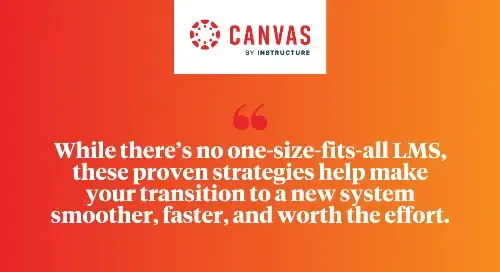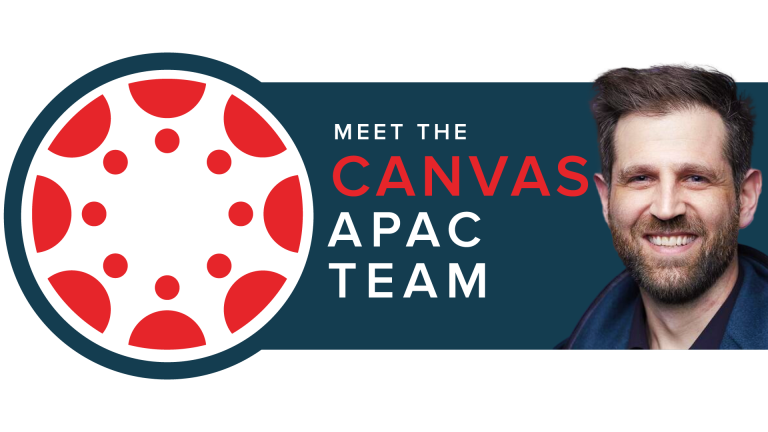
Learning management systems (LMS) are widespread as a digital transformational tool in higher education and vocational education institutions in Australia and New Zealand.
Previously known as a course management system or virtual learning environment, the LMS has proven agile and future-fit as our region moves into the era of hybrid and remote learning thanks to the pandemic.
Implementing this foundation of your instructional technology infrastructure might seem daunting. That’s if you’re investing in your first LMS or upgrading from a legacy system. The process from signing a deal for an LMS to the system going live will look different in each organisation. There is no blanket approach because institutions have individual goals, objectives and strategic themes to drive their learning technologies.
However, these proven strategies can help make your transition to a new system smoother, faster and worth the effort. On average, institutions change their LMS every 10 to 15 years.
Need to turn over a new leaf?
The drivers for change in higher education differ from those in vocational education (VET). University IT leaders say supporting student success, business transformation, and new models of teaching, learning, and delivering services were among their top 10 concerns, according to CAUDIT. The 2021 State of Student Success and Engagement in Higher Education found students’ priority was work/career readiness. Research consistently shows that students say an LMS is one of the keys to their academic success.
When the time came for the University of Newcastle (UoN) to renew the licence of its legacy LMS, it realised the system was neither enterprise-ready nor able to meet the institution’s future needs, says Tammy Robinson, UoN’s Manager, Learning Technology.
“We also had multiple years of course evaluations from students telling us they wanted consistency in their courses. As well, our Vice-Chancellor had been speaking about delivering lectures as a thing of the past, so we absolutely needed to look at new models for teaching and learning,” says Tammy.
As for VET providers, they have a focus on their bottom line.
To be profitable, they must earn government funding. To gain this, they must comply with regulations and support students to complete their courses. A 2021 State of VET survey found 86% of VET providers agreed regulation had a moderate or significant impact on their institutions. And two-thirds of those with a mature LMS said they were more profitable since the onset of COVID-19.
New Zealand’s BCITO works with 9,000+ employers of building and construction apprentices and didn’t have an LMS until 2021. Their Digital Learning Product Owner, Nicki Alori, says before an LMS, there were many inefficiencies, such as inconsistencies in capturing evidence of apprentices’ learning on site.
“There was also no opportunity for our learners to engage with BCITO in a digital space, no scope for us to demonstrate our quality customer care via digital channels to add value.”
BCITO’s new LMS isn’t just for e-learning courses though, it’s the backbone of their business model, offering rich interactivity and learning engagement.
Do this before the clock starts ticking
An LMS is a significant technological asset to integrate into your workflows and processes, though the transition can take from three to 12 months. Importantly, there are ways to fast-track a new LMS by addressing the likely sticking points head-on.
You can speed up the process in the following ways:
- Assign an internal team dedicated to working on the implementation timeline, but not in addition to their substantive roles
- Being clear about taking an ‘as is’ content migration or transformation approach to the project
- Establish a content retention policy - up to 10 years for student data and three years for course content is a useful yardstick
- Communicate early to teachers about tidying up course content and students to download their old submissions
- Archive all of your content, then audit and evaluate what will be migrated
- Partner with an external provider and use your students to help transition content to the new LMS
- Move a dozen of your most complex courses into the new LMS to test them in a sandpit. This should involve academics and training advisors
- Champion change management and supports to help build staff capability to embrace the new LMS, such as drop-in online training, one-on-one sessions and on-demand resources
- Appreciate that once your new LMS has gone live, it’s not set and forget – you’ll need to update and continuously improve it.
The more planning your institution does, the shorter the overlap time between LMS’s, so you’re not paying to run two systems simultaneously.
Plug in to power up
When choosing an LMS, ask questions about interoperability. Does it give your institution the option to integrate with trusted third-party learning tools and applications such as Microsoft Teams, Zoom, Google Docs, for instance?
Ensure your new LMS offers you the flexibility to customise the system to your needs.
Budding up for content migration
Institutions may not have the in-house expertise to migrate their content to a new LMS. This content can be valuable courses that are the bread and butter of your operations, or they could be duplicated and out of date.
Consider first moving all the content to a repository. It’s effectively an archive allowing you time to do an audit inventory to determine what’s worth moving across to your new LMS. Edtech company K16 Solutions partners with institutions to guide and help them migrate clean course content and student data to a new LMS as well as making global changes to branding, terms, or templates.
K16 Solution’s Steve Milner, Chief Revenue Officer, says: “Many institutions and corporations often bring across what are bad processes from the old system into the new one and expect them to be different. That’s why transitioning to a new LMS is a great time to examine your processes and tidy up the content.”
Let’s get collegial
Around the globe, more than 3,000 post-secondary institutions use Instructure’s Canvas LMS. There’s also a vibrant online community of 1.5 million users, from newbies to advanced, who openly share tips, insights, and resources and have their questions answered. It’s a hive of problem-solving, building resilience, and collegiality.
Canvas also runs dynamic face-to-face and online conferences about best practices and new developments, with recordings available. And for those who like a manual or a guide, there’s even a Canvas LMS for Dummies book with a cheat sheet and the Higher Education Guide to LMS Implementation.
So, when it comes to transitioning to a new LMS in a post-pandemic world, it shouldn’t be cumbersome, nor should you need to re-invent the wheel. Get in touch with Canvas to help you transition to your next LMS.
Related Content
 philippines_ched_cmo.png
philippines_ched_cmo.pngBlogs
 meet-canvas-apac-team-avi.png
meet-canvas-apac-team-avi.pngBlogs
 mom_and_baby_with_laptop_2.jpg
mom_and_baby_with_laptop_2.jpgBlogs
